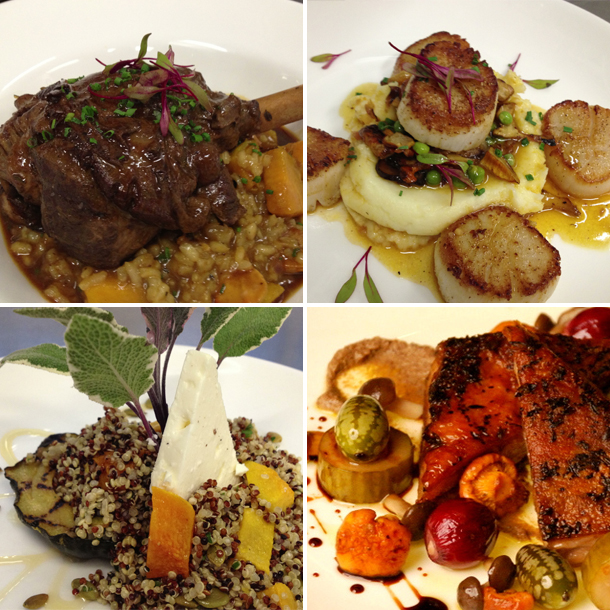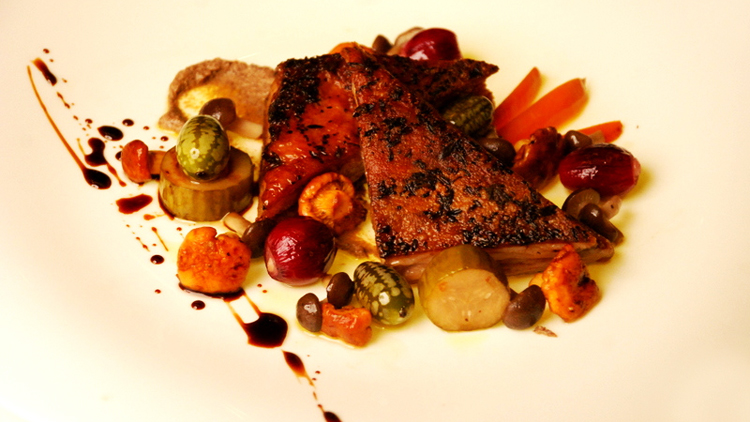Jedediah Hawkins Inn may have been a stop on the Underground Railroad and its original owner may have spent his glory days as a gunrunner, but these unsubstantiated claims that date back 150 years aren’t the only reasons visitors flock here by the hundreds every weekend.
Of course, Civil War legends are great conversation starters, especially when they occur in between gulps of cold beer inside the inn’s 1920s-era speakeasy.
But this charming restaurant and inn, tucked away in the heart of North Fork wine country, with its Italianate-inspired architecture—accentuated by green hues bursting from the facade and high-arching ceilings towering above the sprawling land that surrounds it—is bustling back to life just as a new food trend erupts across Long Island.

Jedediah Hawkins Inn, built in Jamesport in 1863, is among a growing list of farm-to-table restaurants using locally grown products to add a gush of flavor to their dishes, while also paying homage to those spending countless hours producing the food that inspires the finished product. The inn’s executive chef, Richard Kanowsky, couldn’t be happier.
“Around here I go to a farm and [the vegetables] are still warm from the sun,” says Kanowsky, who at 33 years old has already lived in at least 18 states and worked every job imaginable inside a restaurant.
“You start to get to know the farmers,” he adds, sitting inside the Inn’s dimly lit speakeasy on a recent morning. “I mean it’s cool, I’m passionate about cooking, they’re passionate about growing. It’s not like I’m calling somebody at 11 o’clock [and placing an order]. I’m going, and this guy is covered in mud and he’s just like, ‘Here’s 20 pounds of tomatoes I just picked off the vine.’”
It’s that bond between chef and farmer that Kanowsky is most excited about. And having a farm down the block for him to pick up fresh tomatoes from is nice, too.
Kanowsky often finds himself making frequent pit stops on his drive into work for vegetables and other ingredients for the week. There are plenty of times he’ll leave home at 7:30 a.m. and won’t arrive at the restaurant until sometime after noon.
There’s a good chance that whatever he selects from the vine that morning will end up on a customer’s plate just a few hours later.
“The taste and the quality is completely different,” he says, adding that there’s a notable difference cooking “something off a vine that was picked 20 minutes ago perfectly ripe or if you got something that was picked three weeks ago a month under-ripe.”
Restaurants such as Jedediah Hawkins Inn are fortunate to be just miles away from some of the best farms on the East End, but some progressive-thinking business minds inspired by this buy-local philosophy are not afraid to set up shop in Nassau County where local farms are fewer.

Adam Acerra, one of three partners at Market Bistro in Jericho, sought to bring the burgeoning farm-to-table ideology to Nassau after noticing its meteoric rise in Manhattan. He opened his restaurant two years ago, and is encouraged by the response.
“People are taking to it, they love it,” he says outside Market Bistro, a rustic, industrial-themed eatery that uses a giant blackboard to display menu items and features bottled-up produce on shelves adjacent to a wide-open wooden bar.
Acerra is proud of the relationships he’s built with local farms—many that Market Bistro lists on its website. “It makes it more fun,” he says of working alongside these farmers.
The menu is adjusted seasonally depending on what’s sprouting out of the ground. Market Bistro’s current fall menu is replete with dishes that include red cabbage, cauliflower, Brussels sprouts and apples from North Fork farms. Local fluke and oysters from nearby Sexton Island are currently on the menu.
“We’re not going to Washington for oysters,” Acerra says.
Diners at Roots Bistro Gourmand in West Islip encounter a similar experience, with a bit of a modern twist.
Thirty-year-old owner and chef James Orlandi opened the “bistronomic”—short for bistro gastronomic—restaurant with a partner about a year and a half ago. The staff blends the old way of doing things with contemporary techniques to give eaters a one-of-a-kind experience.
“I think they’ve just been held at a standard of what a restaurant should be here and we’re trying to step out of the box and give them something that they would expect in the city, or more importantly, at some of the top restaurants in the world, really,” he says, over the phone.
“Basically anything that hits the table here has come from raw ingredients which we have broken down,” Orlandi adds. “Nothing is frozen or packaged.”
Orlandi’s menu, which evolves depending on the season, includes lamb with a puff pastry top and lobster with sweet corn puree—both with some Long Island pizzazz.
The farm-to-table trend, say these restaurant owners and chefs, will only continue to grow as Long Islanders become increasingly aware of the origin of the food they’re enjoying.
A large number of restaurants—North Fork Table & Inn in Southold, Peppercorn Café in East Patchogue, The Fifth Season in Port Jefferson, Noah’s in Greenport, and many others—buy their produce from local farmers.
“Without farms,” says Acerra of Market Bistro, “you have no food.”
He has a point.

























